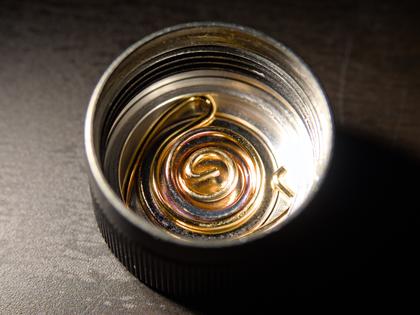The Skilhunt H150 has been recalled. If you have one, remove the battery and contact Skilhunt.
Updated August 2, 2023. The original post remains below.
Skilhunt has recalled the H150 due to the short circuit issue described below. If you have an H150 or ordered one prior to August 2, email service@skilhunt.com for return instructions.
Skilhunt intends to correct and re-release the H150, so future readers who order an H150 after early August 2023 are not affected by this recall. Models other than the H150, such as the M150, E2A, H04, and H300 are not affected by this recall.
If you have a Skilhunt H150, do not use flat-top cells
Shortly after unpacking my Skilhunt H150 review sample, I tried using a flat-top Vapcell H10 in it, as I do with most 14500 lights. It worked at first, but stopped after I installed the light in the headband. When I removed the tailcap, I noticed the spring was discolored and deformed, and the cell was warmer than expected.
The driver has a metal nub, presumably for reverse-polarity protection, which can make contact with a flat-top cell. I measured a dead short between this nub and ground, meaning any contact with the positive terminal will short-circuit the battery. Short-circuiting a Li-ion battery can cause it to explode, and such an explosion inside a metal flashlight can produce shrapnel. This is, of course extremely dangerous, especially when the light is meant to be worn on one's head.
This also means that instead of protecting against harm from inserting a battery backward, a short circuit is guaranteed when a battery in inserted backwards.
The H150 should be recalled
Another community member has confirmed the same issue on their H150, so this isn't just a defective unit. I do not recommend using the H150 at all, with any battery and believe Skilhunt should recall it.
I tested an M150 v2 and there is no continuity between RPP and ground, so that light is safe. I do not have an M150 v3; someone who does should test it.
For those who wish to continue using an H150 despite this risk, cells that have a button top and a protection circuit are the safest option. A button top cell is unlikely to contact the RPP nub, and a protection circuit should interrupt current in the event of a short circuit. NiMH AA batteries are less likely to explode than Li-ion, but can still generate a great deal of heat in the event of a short.
The charging contact on the light is also a mild hazard, as contact with conductive materials can cause sparks. Unlike the M200, I was able to ignite steel wool with it.
I haven't contacted Skilhunt for comment yet, as I believe this is a severe enough flaw to merit warning the community immediately.


Comments
You can use your Mastodon or Lemmy account to reply to this
Reply Reply
Reply
Loading...